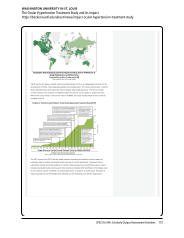14 · Survey Results: Executive Summary
is complicated by the fact that other institutional sup-
port and assessment offices like Institutional Analysis
and Sponsored Programs see this as their function
and tend to act independently of the library.”
Marketing and Publicity
Seventy-three respondents indicated one or more
methods the library uses to promote scholarly output
assessment services. Of these, 54 respondents (74%)
use word of mouth to promote their resources and ser-
vices. The majority of respondents also use LibGuides
and library websites (66% and 60% respectively), while
flyers and brochures are the least used methods of
promotion (21% and 16% respectively). Other methods
specifically identified by respondents include emails
to faculty, library-held wine and cheese events, brown
bag lunches at departments, communications on elec-
tronic display boards, announcements from university
public affairs, and presentations at faculty departmen-
tal meetings.
Advice
Forty-three respondents provided advice to their peers
about scholarly output assessment services. The im-
portance of faculty and administration partners to
success was a common theme. As one respondent
noted, providing the services themselves can help
“build faculty-library liaison relationships.” The need
to understand and respond to different departmental
needs and disciplinary differences was another rec-
ognized theme for building successful partnerships.
The number of tools and continued “flux” of scholarly
output assessment services was highlighted as a chal-
lenge for librarians. Hiring or encouraging librarians
to develop expertise in this area to serve as technical
leads or coordinators for efforts was recommended
by several respondents. One recommendation was
to “have a dedicated position who keeps abreast of
emerging products and resources and then provides
staff development for other faculty and staff.” Another
recommendation was to build programs around ac-
tual researcher scenarios such as “funding applica-
tions, dossiers for renewal and tenure, annual reports,
and promotion.”
Understanding and communicating the strengths
and weaknesses of available tools and measures was
also recognized as an important component of schol-
arly output assessment services provided by librar-
ians. One library commented that tools for scholarly
output assessment services have limitations and to
“be mindful and explicit about this as you introduce,
discuss, and utilize them.” Another respondent ad-
vised honesty about the limitations of bibliographic
tools and “to always make caveats explicit.”
Trends
Fifty-nine respondents identified future trends that
have implications for scholarly output assessment
services in libraries. Several respondents identified
alternative metrics, author identifier profile systems,
and the assessment of scholarly output beyond tra-
ditional publications, including data, as trends. The
proper and evolving use of appropriate metrics across
disciplines was also reported as an important trend, as
was recognition of scholarly output in other formats
such as data, digital humanities, or other digital ob-
jects. Concerns include the accuracy of data sources,
data standardization, data aggregation, data interop-
erability, and author name ambiguity. Respondents
identified adoption of unique author identifier profile
systems, such as ORCID, as being a promising de-
velopment. Other challenges noted by respondents
include proliferation and cost of resources, political
and discipline-specific issues related to promotion and
tenure, staff development needs, and keeping abreast
of trends including federal research requirements.
Conclusions
Based on the survey responses, the majority of the
responding ARL member libraries engage in a variety
of activities related to scholarly output assessment.
These activities reflect the diversity of ways that schol-
ars are creating and disseminating scholarly outputs
to communicate scholarship, as well as the methods
and tools for measuring scholarly impact. The activi-
ties range from formal programs with staff dedicated
to scholarly output assessment services to providing
just-in-time information on resources, tools, or metrics.
Many libraries reported partnerships with various
campus units outside of the library. These partner-
ships demonstrate alliances with the campus com-
munity to leverage opportunities for expertise and




























































































































































































